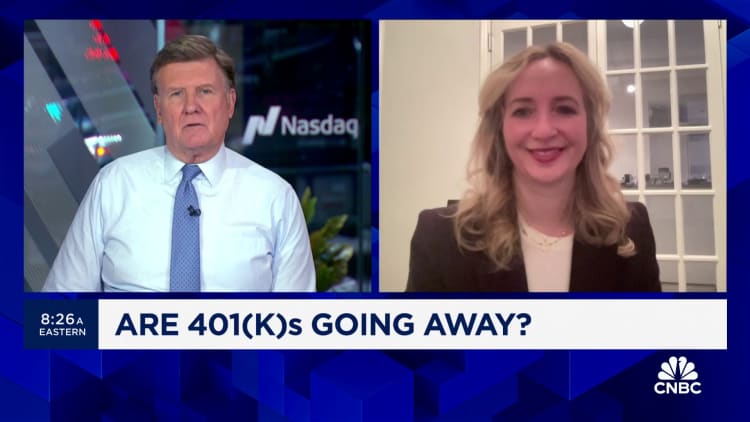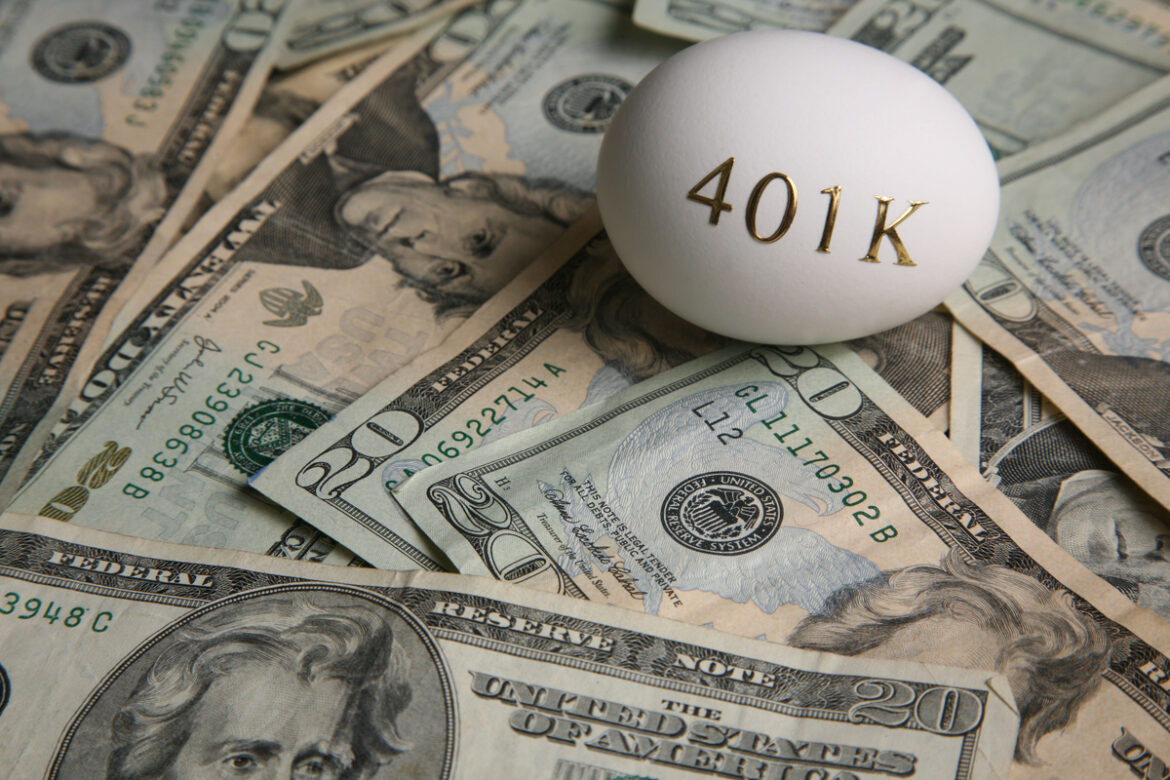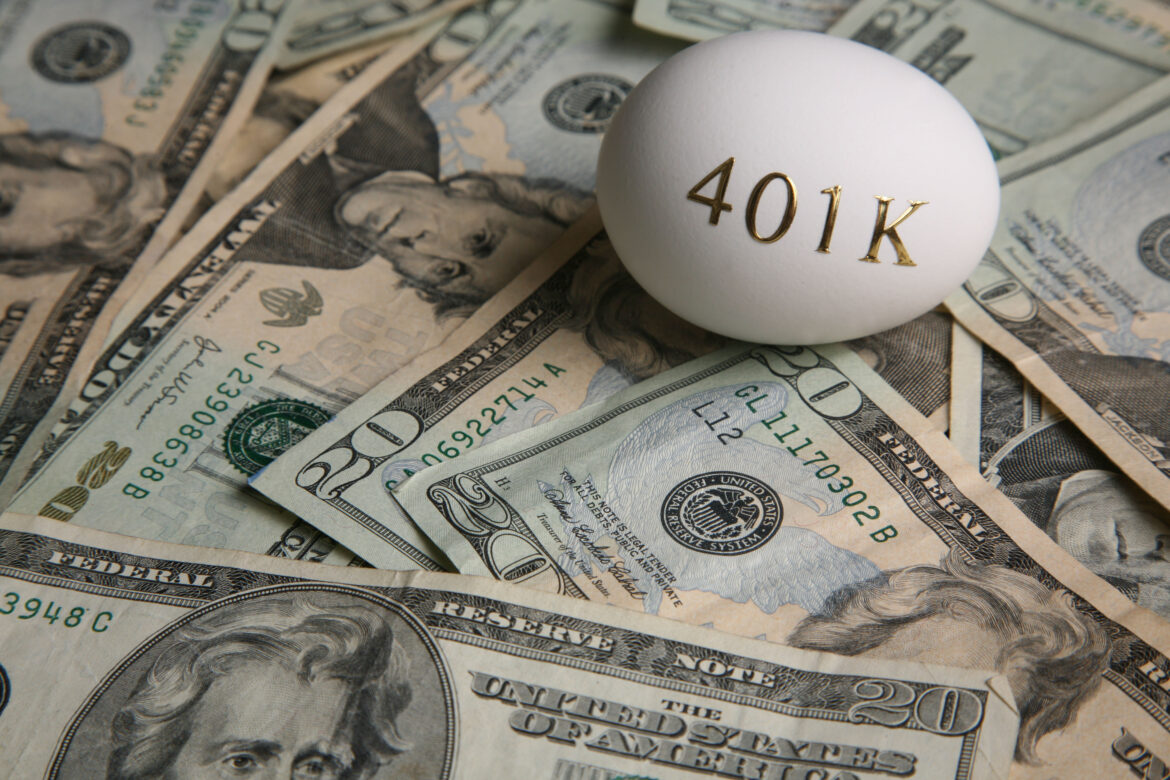
“Do I just have to ‘bite the bullet’ and pay the taxes?”
Source link
401k
Saving $1 million in your 401(k) is no easy accomplishment. Most people never make it to that milestone.
Only the top 3.3% of retirement savers had accumulated over $1 million across their accounts as of the end of the last decade, according to estimates from the Employee Benefit Research Institute, based on the latest Federal Reserve Survey of Consumer Finances. But if you know what those 401(k) millionaires know, you could join this elite group.
They don’t have any insider information. And most didn’t get lucky by vesting company stock in their 401(k) before the price went parabolic. They just understand how to make the most of their 401(k) plan.
Here are three secrets of 401(k) millionaires.

Image source: Getty Images.
1. They always get their full company match
If there’s one thing you must do to make the most of your 401(k), it’s to get the full company match. If you aren’t contributing enough to get it, you’re practically leaving free money on the table.
Every 401(k) plan will have a different matching policy, but the basics are the same for most companies. If you contribute up to a certain percentage of your salary, your company will also contribute an amount up to 100% of your contribution. Some common 401(k) matching contributions are $0.50 per dollar up to 6% of your pay or a dollar-for-dollar match on the first 3% and $0.50 per dollar on the next 2%.
It’s worth pointing out that unless you’re earning a very high income, you can usually get your full company match with contributions well below the limit for a 401(k). For 2024, the 401(k) deductible contribution limit is $23,000, or $30,500 for workers age 50 or older. So it’s not like you need to be some super saver to set yourself up for a $1 million 401(k).
Getting your full company match will typically put your savings rate close to 10% of your salary per year. Even with an average salary of just $60,000 per year, you’ll end up contributing $6,000 per year. If you can consistently do that for a full 40-year career, you’re very likely to end up with $1 million in your 401(k).
2. They always minimize their fees
For all the benefits of a 401(k) plan, they typically come with one major drawback: The fees can be a significant drag on your investment returns. But if you know what the 401(k) millionaires know, you can minimize the impact of fees on your account.
There are three types of 401(k) fees: administrative, service, and investment fees. Unfortunately, you’re stuck paying whatever administrative fees your company plan dictates. But when it comes to service and investment fees, you can exercise a lot more control.
Service fees are the one-time charges you might pay for using some of the features of your 401(k) plan. For example, you might have to pay a service fee to take out a 401(k) loan or use a participant-directed account. Those services are totally optional, so you won’t pay anything if you don’t use them, but the fee could be worth it in some instances.
The bigger cost for most retirement savers are the investment fees. These are charged by funds offered by your 401(k). Finding funds with a low expense ratio will have a massive impact on your overall returns. And the good news is that funds with low expense ratios are usually broad-based index funds, which have historically outperformed actively managed mutual funds, which you might also find in your 401(k) plan.
If you can stick to the lowest-cost funds and avoid unnecessary service fees, you’ll be well on your way to joining the 401(k) millionaires.
3. They never interrupt their investments unnecessarily
The biggest secret of 401(k) millionaires is that they’ve been investing for a long time. What’s more, they haven’t stopped or withdrawn funds until they need to in retirement.
That means they invested in good times and bad. When stocks looked expensive, they still contributed to their 401(k). When the stock market was crashing and everyone was running for the hills, they still contributed to their 401(k). The discipline of consistently contributing and letting compound earnings work for them is what truly separates 401(k) millionaires from the average retirement saver.
If you want to become a 401(k) millionaire, you have to understand the power of compounding. It might not seem like much that first year you contribute 10% of your salary to your 401(k). It might not even feel like much after the fifth year.
But eventually, you’ll see your account growing quicker than you ever imagined as it pushes toward $1 million. That only happens, though, if you keep your money invested and never disrupt it unnecessarily.
If you can manage to consistently invest throughout your career, you should find yourself joining the small group of 401(k) millionaires by the time you’re ready to retire.
Most Americans have the majority of their retirement savings in their company 401(k).
There’s a good reason for that. Not only do 401(k)s offer generous contribution limits, employers will often match contributions up to a certain amount as an employee benefit. That leads many people to prioritize their 401(k) for retirement savings.
Even so, many folks reach retirement age well short of their savings goals. That’s reflected in the average 401(k) balance for retirees age 65 and older. But if you’re savvy, you can come out well above average while making the most of any savings you’re able to accumulate.
Here’s the average 401(k) balance for retirees age 65 and older
The average 401(k) balance for account holders age 65 and older was $232,710 as of the end of 2022, according to data from Vanguard. That’s well short of most people’s retirement savings goals, but even that number may be overstating the reality for the typical retiree. The median account balance for people age 65 and up was just $70,620.
Importantly, the average retiree likely has savings in other accounts. It usually makes sense to roll over your 401(k) to an IRA when you leave your employer to reduce fees and open up more investment options. Additionally, many people save for retirement in a regular brokerage account as well.
Moreover, once you retire, you start to draw down your account. That can reduce your retirement savings, and the impact can be quite noticeable in years when the financial markets decline, like in 2022. Overall, however, given a conservative withdrawal strategy, you can often expect your account value to increase despite regular withdrawals.

Image source: Getty Images.
That said, the median balance across all retirement accounts for people aged 65 to 74 is only $200,000, according to data from the Federal Reserve. Those people also have about $160,000 in stock holdings outside of retirement accounts. Put together, that’s still well short of most people’s retirement needs.
Even when you add in the average monthly Social Security payment of $1,907, most folks will struggle to live the life they envisioned for retirement with just median account balances.
Make the most of what’s available to you
If you find your 401(k) account coming up short as you approach retirement age, there’s only so much you can do. If you can work longer and save more, that’s a great option, but putting off retirement is unappealing and it’s not a possibility for some.
The next best thing you can do is make sure you use a strategic withdrawal strategy from your 401(k) to minimize taxes. Delaying the start of Social Security for a year or two can help put you in a position where you can significantly lower your overall tax bill later in retirement. It may be worth consulting with a financial advisor to see what strategies are available for your situation.
If you still have a lot of time before you reach retirement, it’s worth examining how much you’re saving. Work backward from your goal using reasonable return expectations to see how much you should be saving every month. If you’re not getting the employer match on your 401(k), you should be contributing at least that much to start. Increasing your contribution rate with every raise is a great strategy to boost your savings.
If you want to retire with an above-average balance in your 401(k), you need to do things that are above average during your career. Just a few tweaks can help you do that, and smart strategies in retirement can make more out of the money you do save.
Saving for retirement today isn’t like it was in previous generations. Gone are the days when a pension was standard, replaced by the modern 401(k) plan. The biggest difference? It puts the responsibility of contributing to it on the employees.
But the 401(k) plan can be a powerful wealth-building tool. There are thousands of 401(k) millionaires throughout America, and joining those ranks isn’t as complicated as it might seem.
Here are five secrets to maximizing your 401(k) plan and retiring wealthy.
1. Use the 401(k)
This isn’t a joke. The most straightforward tip for retiring rich is to actually use your 401(k) plan. According to a CNBC study, 4 in 10 people with access to a 401(k) — almost half — don’t contribute anything!
You can compound zero dollars as much as you want, but you won’t get anywhere. The first step is making sure you’re contributing something.
2. Contribute enough
Once you’re actively contributing, you must figure out how much you’ll need to put into it to reach your goals. Hypothetically, suppose you’re 30 and want to retire with $1 million in your account. The average salary in the U.S. is around $60,000 for 30-year-olds. Historically, the stock market returns an average of 10% annually. You mix in some bonds, and your 401(k) grows by an average of 8% annually.
To reach your goal, you must contribute $440 of your monthly gross pay, which is $5,280 or 8.8% of your salary. Calculate how much you must contribute at your age and income to hit your goal. Having a goal should be the first step in any retirement plan. It all comes together from there.
3. Get free money
Some employers offer a match to help encourage employees to save money. It’s usually a dollar-for-dollar match or a one-for-two match up to a certain salary percentage. For example, a dollar-for-dollar match up to 4% would mean that your employer would match every dollar you contribute until you cross that 4% threshold.
A dollar-for-dollar match doubles your out-of-pocket money before it even goes to work, so be sure you get all the easy money you can!

Image source: Getty Images
4. Don’t touch your funds
It’s crucial that you don’t interrupt the compounding magic of a retirement account. Not only would withdrawing your funds early incur a potential 10% penalty and taxes, but that money would also cease working for you. There are ways to access your 401(k), including borrowing against it, but just because you can doesn’t mean you should. Leave that money alone.
5. Don’t be afraid of risk
One of the worst things young workers can do in their 401(k) is get too conservative with how they invest their money. If you are young, you should put very little of your savings into fixed-income funds. Instead, you should invest in stocks that are more volatile than bonds but have far more long-term upside. Otherwise, your money will never grow like it can.
If you’re uncomfortable with stock market volatility, remember that most 401(k) plans only allow you to own mutual and index funds. It’s very easy to diversify your savings, and you can slowly start to shift toward conservative investments as you age.
Wrapping up
Retiring with a nest egg you’re proud of takes work and time, but the formula for success is refreshingly simple. Invest responsibly. Do it early and often in life. And don’t mess with any money you put into your 401(k). Don’t be reckless, but embrace a little risk and let time do all the heavy financial lifting. It’s as simple as that.

At age 60, you’re not too far from retirement. In fact, the average retirement age is 61, although there are plenty of Americans who continue working into their late 60s and beyond.
It’s always important to know whether you’re on track with your retirement savings. That’s especially true as you reach your 60s, since you’re getting close to the end of your career. If you’re trying to figure out where you stand, you’ll find data on the average 401(k) balance below, plus some tips on what to do if you need to save more.
Bonus offer: unlock best-in-class perks with this brokerage account
Read more: best online stock brokers for beginners
The average 60-year-old’s 401(k) balance
The average 60-year-old has $70,000 to $210,000 in their 401(k). Why such a wide range? There are two recent sources with a fairly large difference:
-
Vanguard reported that Americans ages 55 to 64 have a median 401(k) balance of $70,620 and an average balance of $232,710 in How America Saves 2023.
-
A 2024 Empower article reported that Americans in their 60s have a median 401(k) balance of $209,382 and an average balance of $555,621.
The median balances are likely a more accurate representation of the overall average. When there’s a big difference between a median and an average, it’s because outliers are having an outsized impact on the average. In this case, people with very high 401(k) balances bring up the average quite a bit.
A popular guideline on retirement savings is to save eight times your salary by age 60 and 10 times your salary by 67. Many 60-year-olds are likely well behind that guideline, based on the recent data. To be fair, some Americans also have other forms of retirement savings, such as individual retirement accounts (IRAs).
What to do if you’re behind on your retirement savings
Even at 60, there’s still time to make significant contributions to your retirement savings. If you feel like you won’t have enough money to retire, here’s what you can do.
Max out your 401(k) contributions
The 401(k) contribution limit is $23,000 in 2024. But one of the advantages of being 50 or older is that you can also make additional catch-up contributions of up to $7,500, for a combined limit of $30,500. If you can’t contribute that much, try to at least put in enough to max out any 401(k) match your employer offers.
Contribute to an IRA, too
Just like 401(k) plans, IRAs allow you to save for retirement while saving on taxes. The contribution limit is $7,000 in 2024. When you’re 50 or older, you can make additional catch-up contributions of up to $1,000, for a combined limit of $8,000.
Retire later
There are several financial benefits to delaying your retirement. By working longer, you’ll be able to save more. You’ll start withdrawing from your retirement savings later, and you can also delay taking Social Security. If you wait until age 70, you’ll receive your maximum Social Security benefits.
Consider relocating or downsizing
Another way to make up the gap in your retirement savings is to reduce your cost of living. You could start looking into areas with a lower cost of living for after you retire — some people even choose to retire abroad. If you want to stay in your current city, you could move to a smaller, more affordable home.
If you can max out your 401(k) and IRA, that’s $38,500 in retirement savings per year, and potentially more if contribution limits increase. After five years, you’ll have added $192,500 to your retirement. That money could also grow if you invest in stocks and bonds.
Most people can’t max out all their retirement accounts, so don’t feel bad if you aren’t contributing that much. Just put in as much as you can. If you do that, combined with potentially working longer and cutting costs, you can still retire with financial security.
Alert: our top-rated cash back card now has 0% intro APR until 2025
This credit card is not just good – it’s so exceptional that our experts use it personally. It features a lengthy 0% intro APR period, a cash back rate of up to 5%, and all somehow for no annual fee!
Click here to read our full review for free and apply in just 2 minutes.
We’re firm believers in the Golden Rule, which is why editorial opinions are ours alone and have not been previously reviewed, approved, or endorsed by included advertisers. The Ascent does not cover all offers on the market. Editorial content from The Ascent is separate from The Motley Fool editorial content and is created by a different analyst team.The Motley Fool has a disclosure policy.
Here’s How Much the Average 60-Year-Old Has in Their 401(k) was originally published by The Motley Fool
You should expect to need savings on top of Social Security once your retirement kicks off. But you have options when it comes to choosing a home for your nest egg. Those might include a traditional IRA, a Roth IRA, or a traditional 401(k) plan offered by your employer.
These days, though, a growing number of 401(k) plans are including a Roth savings feature. And that’s an option you may be tempted to take advantage of — especially this year because Roth 401(k)s are no longer forcing savers to take required minimum distributions.

Image source: Getty Images.
While a Roth 401(k) might seem like a great home for your retirement savings, there are certain pitfalls you might encounter if you choose one of these accounts. Here are three reasons you may not want a Roth 401(k) to serve as your nest egg’s home.
1. You have limited investment choices
The nice thing about saving for retirement in an IRA is that you get a world of investment options to choose from. Want to load up on individual stocks you research yourself? Go for it.
With a 401(k), you’re generally limited to several different funds. Within that realm, some funds may come with lower expense ratios than others. Either way, you’ll still be limited as to how you invest your retirement savings, so an IRA may be a better bet.
If you want the benefit of tax-free investment gains and withdrawals, you can always choose the Roth version of an IRA. Even if your income is too high for a Roth, there’s always the conversion option.
2. Your plan fees are high
The investments you choose for your 401(k) could leave you paying a lot of money in fees. But even if you opt for low-cost investments, like index funds, you might still get hit with fees associated with administering your 401(k).
Those fees, like investment-specific fees, could eat away at your returns over time. With an IRA, your fees may be lower.
3. There’s no employer match
Contributing to a 401(k) plan makes sense when there are employer-matching dollars to take advantage of. Data from Vanguard finds that within its platform, 95% of retirement plans come with some type of matching contribution on the part of a sponsoring employer.
But if you’re in that unlucky 5%, it may not be worth it to contribute to a Roth 401(k) if the above circumstances apply to you. If there’s no workplace match, you may want to max out an IRA first. Then, if you wish to contribute beyond that point, you can divert extra funds to a Roth 401(k).
You may also want to keep some of your retirement savings outside a tax-advantaged account. That way, your money will be completely unrestricted.
Roth 401(k)s give you many of the benefits of Roth IRAs but with higher contribution limits. As you can see, however, there are drawbacks to making a Roth 401(k) the home for your retirement savings, so you may want to consider a different solution.
More Americans had balances of $1 million or more in their 401(k) plans than ever before in 2023, according to Fidelity Investments. The company, one of the biggest providers of employer retirement plans, recently released data that revealed the number of its 401(k) accounts with at least $1 million totaled close to 422,000 at the end of last year.
Whether your retirement plan is with Fidelity or another company, joining the ranks of wealthy individuals could be a real possibility. Want to be a 401(k) millionaire? Here are seven tips you should know.

Image source: Getty Images.
1. Start investing early
Arguably the best investing advice you’ll ever get is to start socking money away as early as possible. Time is your greatest ally in building a sizable nest egg.
If you started investing $2,100 per year in a 401(k) plan at age 25 and kept it up, you’d have over $1 million at age 65 assuming a return of 10% (roughly the average long-term return of the S&P 500). If you waited until age 45 to begin investing, you’d have to save a whopping $16,000 per year to grow your account balance to $1 million.
2. Invest regularly
Time in the market beats trying to time the market — hands down. Investing regularly is the best way to build up your 401(k) account. Set up an automatic deduction from your paycheck that flows directly into your 401(k). It’s easy and ensures you’re consistently investing.
3. Maximize your employer match
How would you like a 100% return on your investment? You can get it with a 401(k) employer match. Many employers offer them. You should at least contribute the amount needed to maximize your employer match. Don’t turn down free money.
4. Minimize fees
While employer matches provide a major tailwind for your 401(k), fees can be a significant drag. Check out the annual expenses of all the investment alternatives your 401(k) plan offers. If the fees for one option appear much higher than others, research it to see if the returns it has provided over the long term are worth the added cost.
5. Don’t invest too conservatively
It could be tempting to invest too conservatively, especially if you begin during a period when the stock market is highly volatile. Over the long run, however, stocks offer the highest returns of any investment alternative. Investing in index funds that own stocks can be a good way to avoid being overly conservative.
6. Take advantage of catch-up contributions
The current standard maximum annual individual contribution to 401(k) plans is $23,000. This maximum amount typically increases each year. However, if you’re 50 or older, you can invest even more money via catch-up contributions. For 2024, the catch-up contribution limit is $7,500. Taking advantage of this opportunity to save more for retirement is especially wise if you didn’t begin investing early in your career.
7. Rebalance your portfolio over time
Imagine a scenario where your 401(k) account tops $1 million only a year or two away from retirement. Then the stock market crashes, wiping out half of your savings. Unfortunately, there’s a real possibility that this could happen.
While you shouldn’t invest too conservatively throughout most of your career, investing too aggressively during the years leading up to your retirement can also be problematic. Rebalancing your portfolio over time (i.e., shifting money from more aggressive investments such as stocks to more conservative investments like bonds) can be a good way to reduce your risk.
Investing your 401(k) account in a target date fund automates this process. The closer you get to the target date (your retirement year), the greater the allocation will be toward less aggressive investments.
Many people are of the opinion that it’s perfectly fine to fall back on Social Security for retirement income. But that strategy could make your senior years a lot less enjoyable.
Social Security will only replace about 40% of your pre-retirement paycheck if you earn an average wage. And many seniors need a good 70% to 80% of their former income to live comfortably — hence the need for personal savings on top of those monthly benefits.
When it comes to saving for retirement, you have choices. Anyone with earned income is eligible to open and save in an IRA. But if your employer offers a 401(k) plan, you may be inclined to sign up and take advantage. If you’re going to do that, though, here are some steps you can take to help ensure that you’re making the most of that retirement plan.

Image source: Getty Images.
1. Snag your full employer match
Vanguard reports that 95% of its employer plans offer some type of matching incentive. If your 401(k) comes with a match, do your very best to snag it in full. Not only is that free money for your retirement, but it’s money you can invest at present to grow your balance further.
Let’s say you get $3,000 in employer matching dollars in your 401(k) this year. If your plan generates an average 8% yearly return over time, which is a bit below the stock market’s average return, that $3,000 will be worth over $44,000 in 35 years.
2. Aim to keep your fees low
One downside of saving for retirement in a 401(k) plan is that you’re generally limited to a bunch of different funds. IRAs, on the other hand, typically allow you to invest your savings in stocks. And that could be a far more cost-effective option.
Many of the funds you’ll commonly find in 401(k)s are notorious for charging costly fees — notably, mutual funds and target date funds. So if you’re going to invest your 401(k), consider going heavy on index funds. Because these funds are passively managed, they don’t tend to charge nearly the same fees (known as expense ratios) as their actively managed counterparts.
3. Consider a Roth
It’s not a given that your employer’s 401(k) will include a Roth savings feature. But if you do have access to a Roth 401(k), it could pay to forgo an up-front tax break on your contributions in exchange for the benefits involved.
Investment gains in a Roth 401(k) are yours to enjoy tax-free, whereas with a traditional 401(k), you’re paying taxes on gains eventually. So if you contribute $100,000 to a Roth 401(k) over time and your balance ends up being worth $500,000, you get to walk away with a $400,000 gain without the IRS getting a piece of it.
Plus, with a Roth 401(k), you set yourself up with tax-free withdrawals during retirement. That could ease a lot of the financial stress you might encounter once you shift into a lifestyle that has you living off savings, as opposed to earning money.
Also, don’t forget that as of this year, Roth 401(k)s no longer impose required minimum distributions. That gives you more say over how you manage your savings.
You don’t have to save for retirement in a 401(k), and that option may not even be on the table. But if it is, and you decide to sign up to your employer’s plan, make sure to claim your complete match every year. Choose your investments savvily to minimize your fees, and think seriously about putting your money in a Roth 401(k).
Retirement balances at their highest in nearly 2 years; 401(k) millionaires jump

The fourth quarter ended on an upswing for retirement savers.
Retirement-account balances hit their highest levels in two years amid improved market conditions and consistent savings rates, according to Fidelity Investments.
The average 401(k) account balance was $118,600 in the fourth quarter, up 14% from a year ago, Fidelity said. The average IRA balance was $116,600, up 12% from a year ago. The average 403(b) balance was $106,100, up 14% from a year ago.
“This past year ended on a high note for retirement savers,” said Sharon Brovelli, president of workplace investing at Fidelity Investments. “When it comes to matters like market stability and economic events, 2023 gave us the highs of the highs and the lows of the lows, but encouragingly, many retirement savers took the long view and stayed the course through it all, which is the type of commitment that can lead to a secure financial future.”
For Gen X workers who had invested in a 401(k) for 15 years straight, the average balance topped half a million dollars ($501,000) at year-end 2023, which Fidelity said illustrated the benefits of consistent long-term savings. Gen X represents people born from 1965 to 1980.
The fourth quarter also saw a jump in the number of 401(k) millionaires, Fidelity said. The number of people with at least $1 million in their 401(k) increased to 422,000, up 20% from the third quarter of 2023, when the number of millionaires had dropped due to market conditions. The fourth quarter also showed an 11.5% increase from the second quarter of 2023.
“Americans love that millionaire title or that idea of a million dollars,” said Michael Shamrell, vice president of thought leadership at Fidelity’s workplace investing division. “The 401(k) millionaires demonstrate a lot of positive attributes. The average tenure of the millionaires is 26 years. That’s going back to 1998. They’ve seen the dot-com crash, 9/11, they’ve seen the market go up and down and they are examples of staying the course.”
The savings rate for the millionaire investors was 26.6%, which includes their personal investments as well as contributions from their employer, Shamrell said.
“Admittedly, not everyone can save at those rates,” he said.
Overall, the total 401(k) savings rate remained steady at 13.9%, including employee and employer contributions, which was consistent with the second and third quarters of 2023 and up slightly from the prior year’s fourth-quarter rate of 13.7%, Fidelity said.
And in 2023, 37% of workers increased their retirement-savings contribution rate, Fidelity said.
With required minimum distributions not kicking in until age 73, according to provisions in 2022’s Secure 2.0 Act, most pre-retirees and retirees under age 70 maintained a savings mindset and did not withdraw from their 401(k) plans. Only 20% of retirees ages 70 to 72 made 401(k) withdrawals. A total of 94% of retirees ages 73 and older made 401(k) withdrawals in 2023.
Among Gen Z investors — those in the generation born from 1997 to 2012 — the number of Roth IRA accounts increased by 50% in the fourth quarter of 2023, compared with the same period of the previous year. Roth IRAs feature after-tax contributions and tax-free withdrawals.
“We continue to see positive savings behaviors across the board for Gen Z. The numbers are really positive,” Shamrell said. “We need to keep an eye on them, as the oldest [Gen Z members] are approaching their late 20s, when they might be thinking about getting married and buying a house. We want to keep an eye on them to see if the positive savings behavior continues.”
401(k) millionaires and average balances rose in 2023, Fidelity says

In a year that defied most economists’ expectations, retirement savers reaped the benefits.
Retirement account balances, which took a sharp nosedive in 2022 due to market volatility, have now started to bounce back, according to the latest data from Fidelity Investments, the nation’s largest provider of 401(k) savings plans. The financial services firm handles more than 45 million retirement accounts total.
The average 401(k) balance ended 2023 up 14% from a year earlier to $118,600, Fidelity found.
The average individual retirement account balance also gained 12% year over year to $116,600 in the fourth quarter of 2023.
“This past year ended on a high note for retirement savers,” said Sharon Brovelli, president of workplace investing at Fidelity Investments.
Positive savings behaviors were key to realizing better outcomes, added Mike Shamrell, Fidelity’s vice president of thought leadership.
A great year for the major indexes also helped. The Nasdaq soared 43% in 2023, while the S&P 500 notched a 24% annual gain and the Dow Jones Industrial Average rose more than 13%.
Number of 401(k) millionaires jumps 11.5%
At the end of 2023, signs that inflation was cooling were not only good news for the economy, but they were also good news for stocks. After the S&P 500 closed out 2023 with a nine-week win streak, the number of Fidelity 401(k) plans with a balance of $1 million or more increased 20% from the third quarter.
Year over year, the number of 401(k) millionaires rose 11.5%.
“These are the poster children of staying the course and taking a long-term approach,” Shamrell said.
Overall, more than one-third of retirement savers increased their retirement savings contributions, Fidelity found. The average 401(k) contribution rate, including employer and employee contributions, now stands at 13.9%, just below Fidelity’s suggested savings rate of 15%.
More retirement savers are borrowing from their 401(k)
Federal law allows workers to borrow up to 50% of their account balance, or $50,000, whichever is less. However many financial experts similarly advise against tapping a 401(k) before exhausting all other alternatives since you’ll also be forfeiting the power of compound interest.
More from Personal Finance:
Why Social Security beneficiaries may owe more taxes
78% of near-retirees failed or barely passed this quiz
How one beach city is helping residents age in place
At the same time, many households are also leaning heavily on credit cards to make ends meet, other research shows.
Across all ages and income levels, more than one-third of adults have more credit card debt than emergency savings, according to a recent report by Bankrate.
“At a time of record-high credit card rates, we see a record-high number of Americans carrying credit card debt that exceeds their emergency savings,” said Greg McBride, chief financial analyst at Bankrate.
During times of financial stress, it may make sense to borrow from a retirement account, rather than rely on such high-interest debt, according to Fidelity’s Shamrell.
“If you have been in a financial bind and the choice is a high-interest credit card or a loan from your 401(k), sometimes the loan is your optimal choice,” he said.
“But that’s in a time of real financial need,” he added, “not going to your college roommate’s wedding in Napa.”
Unlike credit card and other debt, savers who borrow from their 401(k) pay themselves back with interest. Interest rates are also generally much lower than those of credit cards, which are currently at a record high over 21%.
Don’t miss these stories from CNBC PRO:










